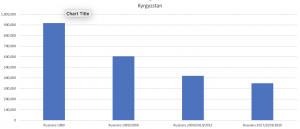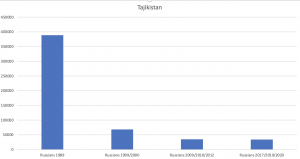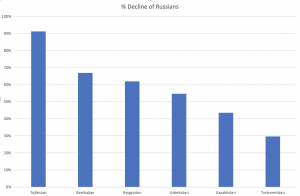86 Central Asia:
Population Geography I –
Post-Soviet Russian Populations
A key piece of Soviet ethnic policy was Russification. While the Soviet strategists strove to create Soviet men and women, the also viewed that political identity as having a Russian cultural identity. Additionally, as part of maintaining control over the various ethnic regions of the country – republics and lower level ethnic regions, the Soviet government sent Russians to work in the political administrations of these regions. The typical pattern was that the highest ranking official would be from the titular nationality, but that the next in line would be a Russian, who would have de facto authority over that top ethnic official. For instance, in Uzbekistan, the top official would be an Uzbek, but a Russian would be second, yet actually with more authority. As a result, numerous Russians were moved to the various republics, including those in Central Asia. However, the Soviet Union dissolved about thirty years ago, so what happened to all those Russians? The status of Russians in the so-called “near abroad” declined with the end of their benefactor, the Soviet government.
It seems logical that Russian population in these countries would vary due to historical links, distance, and quality of life. With the aid of tables and charts, let’s take a look and try to assess this..
During the years of the Soviet Union, most countries that this textbook places in Central Asia were republics within that same country, the USSR. Soviet demographers were on a set schedule, producing a census for years ending in -9; for instance, we have numbers here for 1989. After the breakup of the Soviet Union, the new countries designated their own census schedules; thus, we have number for different years for different countries. We have tried to group them together in reasonable ways.
| Country | Native Ethnic Group 1989 | Russians 1989 | Natives 1999/2000 | Russians 1999/2000 | Natives 2009/2012 | Russians 2009/2012 | Natives 2017/2019/2020 | Russians 2017/2019/2020 |
|---|---|---|---|---|---|---|---|---|
| Azerbaijan | 5804980 | 392304 | 7205464 | 141687 | 8172809 | 119307 | 10282283 | 130000 |
| Kazakhstan | 6534616 | 6227549 | 8011452 | 4480675 | 10096763 | 3793764 | 12764821 | 3512925 |
| Kyrgyzstan | 2229663 | 916558 | 3128147 | 603201 | 3804788 | 419583 | 4695646 | 348935 |
| Tajikistan | 3172420 | 388481 | 4898400 | 68200 | 6373834 | 34838 | 7579306 | 34000 |
| Turkmenistan | 2536606 | 317333 | 3403609 | 297319 | 4066959 | 242307 | 4742900 | 223200 |
| Uzbekistan | 14142475 | 1653478 | 18502400 | 1272040 | 26917700 | 750000 |
Let’s start with Kazakhstan. You see the raw data in the table above, but let’s look for the pattern in the bar graph.

Kazakhstan
This Central Asian country has a lengthy border with Russia. As the physical geography of southwestern Siberia is not so different from that of northwestern Kazakhstan, this Central Asian location probably feels somewhat familiar to many Russians traveling or living there. Given its immediate proximity as a bordering country, Kazakhstan offered a convenient location for Russians to live. Many Russians lived in northern Kazakhstan for quite a few years during the Soviet period. The standard of living in Kazakhstan is reasonably similar to that in much of Russia. Although the Kazakh capital city is attractive and modern, it cannot yet compare to Moscow or St. Petersburg in Russia. Even so, the Human Development Index ranks Kazakhstan higher than Russia.
Russian presence in these lands goes back several centuries, well into the Tsarist period. At times, portions of what is now Kazakhstan were in the Russian Republic of the Soviet Union. During the Khrushchev period of the Soviet era, many Russians moved to Kazakhstan as part of the “Virgin Lands” agricultural expansion.

It is a shorter distance of moving back to Russia, so a number of Russians took on that migration; however, the relative comfort of northern Kazakhstan deterred a larger flow of out-migration. Considerable mineral resources in northern Kazakhstan have contributed to well-being there. The movement of the capital city from Almaty in the country’s southeastern corner near Kyrgyzstan to Astana (now Nur-Sultan) in the north-central region also brought more attention and prosperity toward regions with a higher Russian population.

Azerbaijan
This country is west of the Caspian Sea and also borders Russia. Russians have been in Azerbaijan for decades, principally in the capital city Baku and connected to the oil industry. Oil incomes in a relatively small country have increased well-being. Baku has received numerous expensive improvements, buildings, and other projects. As with Kazakhstan, the HDI ranks Azerbaijan higher than Russia.
However, Azerbaijan is a Muslim country, which is counter to Russia’s Orthodox faith. Given the immediate proximity of Russia to Azerbaijan, with the breakup of the USSR, many Russians left to return to their own Russia, larger due to religious and cultural differences. However, since the initial rush to leave, Russian population in Azerbaijan has remained stable, while Baku and the Caspian coastline have been popular tourist destinations for Russians.

Kyrgyzstan
Russians had a surprisingly large contingent in Kyrgyzstan. For some Russians, their connection to Kyrgyzstan is even older than that of Soviet days; rather, it extends back to Tsarist control over Central Asia. Some Russian families in Kyrgyzstan, especially near the capital city Bishkek, trace back to this era. Given the lack of a border with Russia and the low HDI score for Kyrgyzstan, perhaps we would expect a sharper decline in post-Soviet Russian population there. The slope of decline has been steady, but not precipitous. Perhaps the greater distance from Kyrgyzstan to Russia, especially to western regions, deters migration.
Turkmenistan
A steady but modest decline in the Russian population of Turkmenistan is perhaps similar to that of Kyrgyzstan, more distant from Russia and low in development. Of note in Turkmenistan is a 2003 law that ended a dual citizenship policy with Russia. As this caused Russians in Turkmenistan to lose their property, many chose to migrate out of the country. The bizarre dictatorship in Turkmenistan seemingly would prompt Russians to want to leave.
Uzbekistan
(Missing some data for Uzbekistan, we are skipping the chart, as it would be inconsistent with the other displays.) A look at the numbers in the data table above shows that Uzbekistan ranked second among Central Asian countries for the number of Russians living there at the end of the Soviet period. Many Russians were involved in government and in management of many industry including the prominent cotton agricultural industry. Overall, the decline in Russian population was near the midpoint in comparison to all Central Asian countries.

Tajikistan
The drop in Russian population was very steep in Tajikistan. This seems logical, as the country is the most distant from Russia (let’s get out of here!) and ranks the lowest in development (this is not a nice place to live).

In sum, Russian populations in Central Asian countries has declined since the USSR dissolved. In each of these countries, the end of the Soviet Union prompted an immediate migration of Russians back “home” to Russia. Even after that initial shockwave, Russians have continued to leave Central Asia but at a slower pace. With it longer historical connection with Russia and its similarities to southwestern Siberia, Kazakhstan still has the largest number of Russians remaining there.
Did you know?
The war in Ukraine has prompted some Russians, often young adults in the tech sector, to leave Russia. Popular destinations include Georgia and Armenia, but also for Central Asia, a key choice is Kyrgyzstan.
The Russian mortality paradox shows that Russians in Central Asia often have lower life expectancies than native peoples there. This paradox occurs even though Russians have lower infant mortality rates and have higher incomes than native peoples there. The causes of higher mortality appears to be culturally caused, in particular by higher alcohol consumption and abuse.
Given that Afghanistan was not in the Soviet Union, we did not consider Russian population there. However, as the end of the Russian war in Afghanistan coincided fairly closely with the end of the Soviet Union, Russian population in Afghanistan went from a peak of about 115,000 soldiers to perhaps only a few hundred people after the war.
Do you understand?
Cited and additional bibliography:
“Demographics of Azerbaijan.” Wikipedia, 9 June 2022. Wikipedia, https://en.wikipedia.org/w/index.php?title=Demographics_of_Azerbaijan&oldid=1092374477.
-
and the corresponding pages for the other Central Asian states
Guillot, Michel, et al. “Understanding the ‘Russian Mortality Paradox’ in Central Asia: Evidence from Kyrgyzstan.” Demography, vol. 48, no. 3, Aug. 2011, pp. 1081–104, https://www.ncbi.nlm.nih.gov/pmc/articles/PMC3315848/.
Imanaliyeva , Ayzirek. Kyrgyzstan Joins the List of Countries Favored by Russia’s Emigres. Eurasia net, 18 Mar. 2022, https://eurasianet.org/kyrgyzstan-joins-the-list-of-countries-favored-by-russias-emigres.
Russia vs. Azerbaijan – Country Comparison. https://www.indexmundi.com/factbook/compare/russia.azerbaijan.
-
and the corresponding pages for the other Central Asian states
Standard of Living by Country | Quality of Life by Country 2022. https://worldpopulationreview.com/country-rankings/standard-of-living-by-country.


